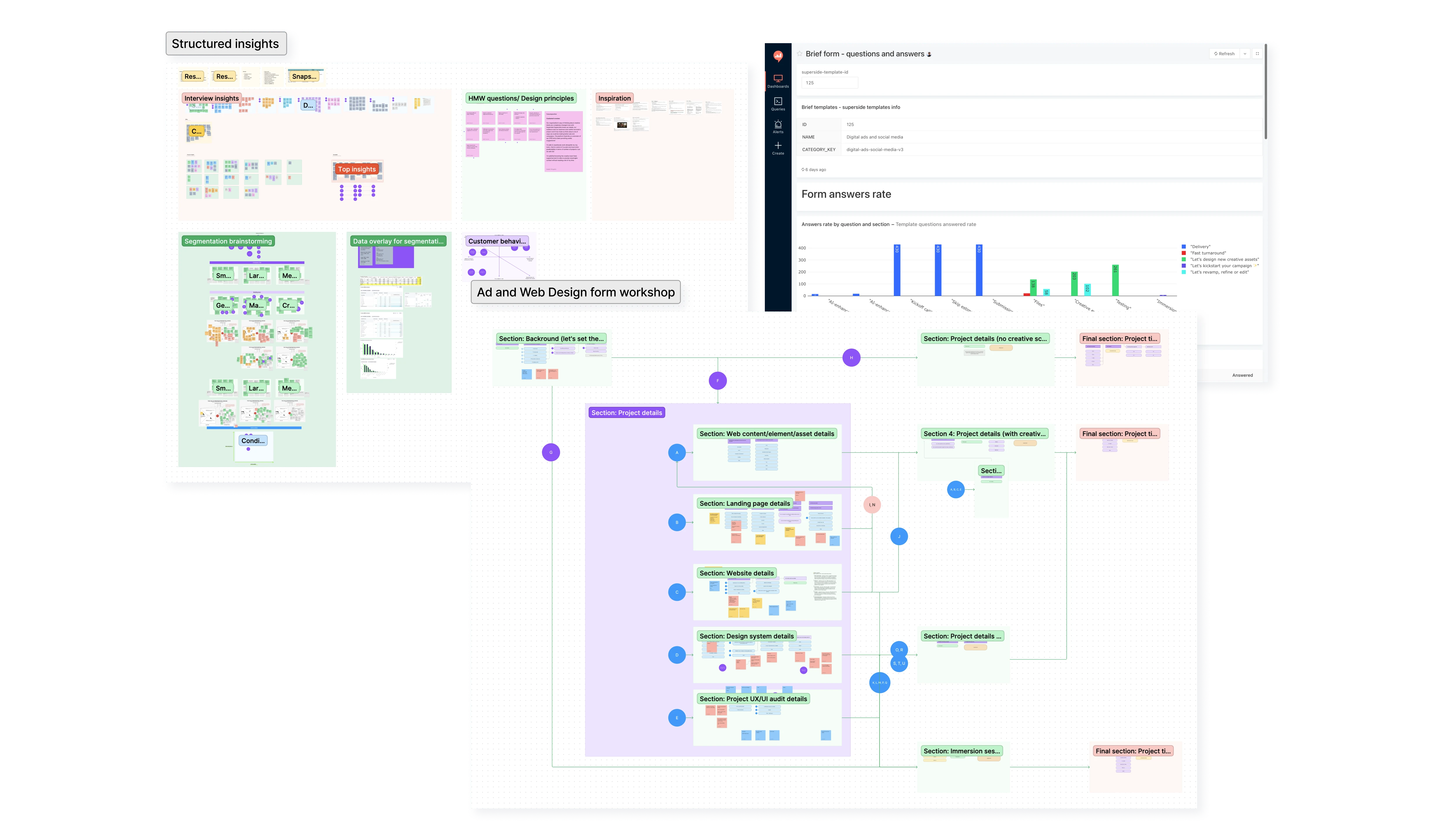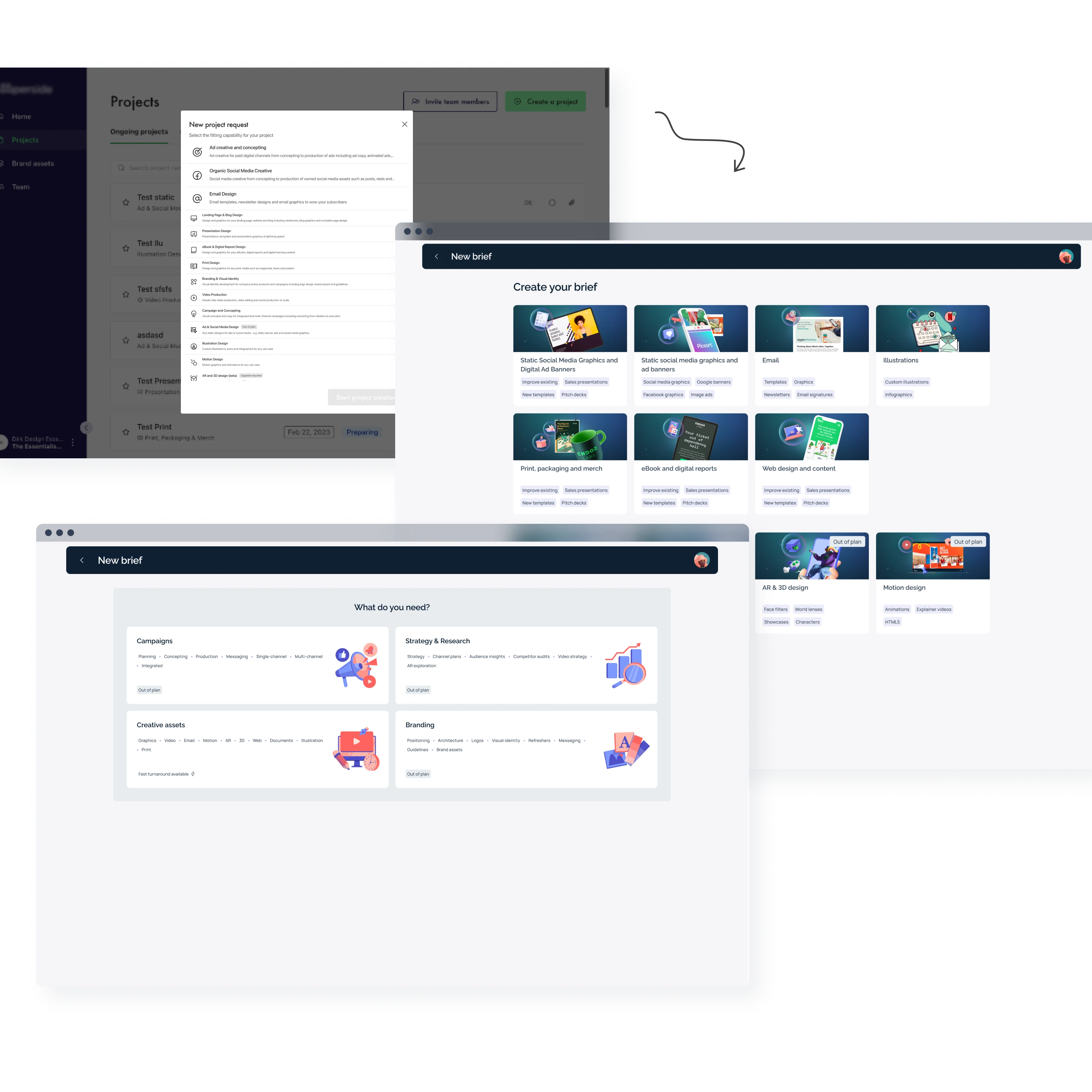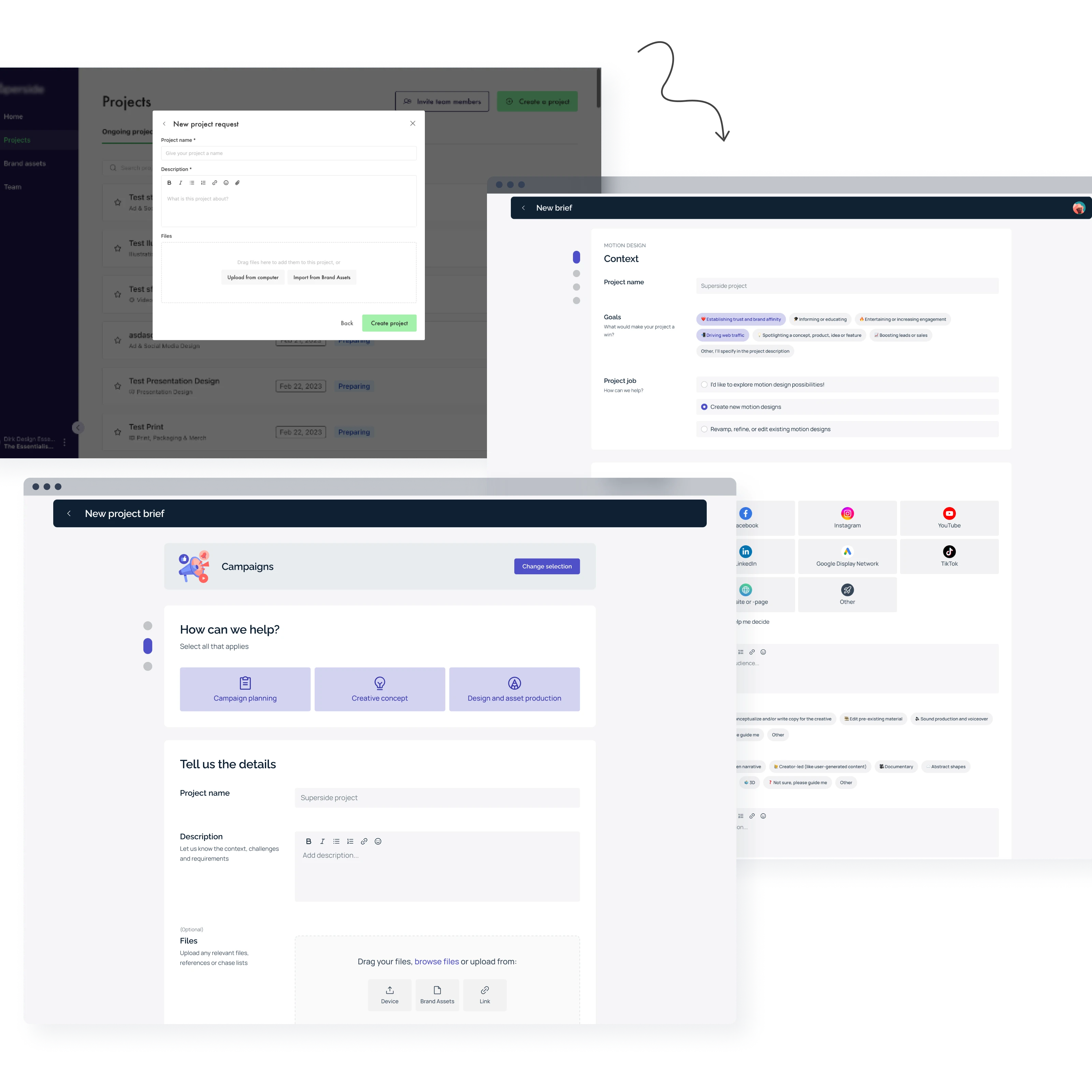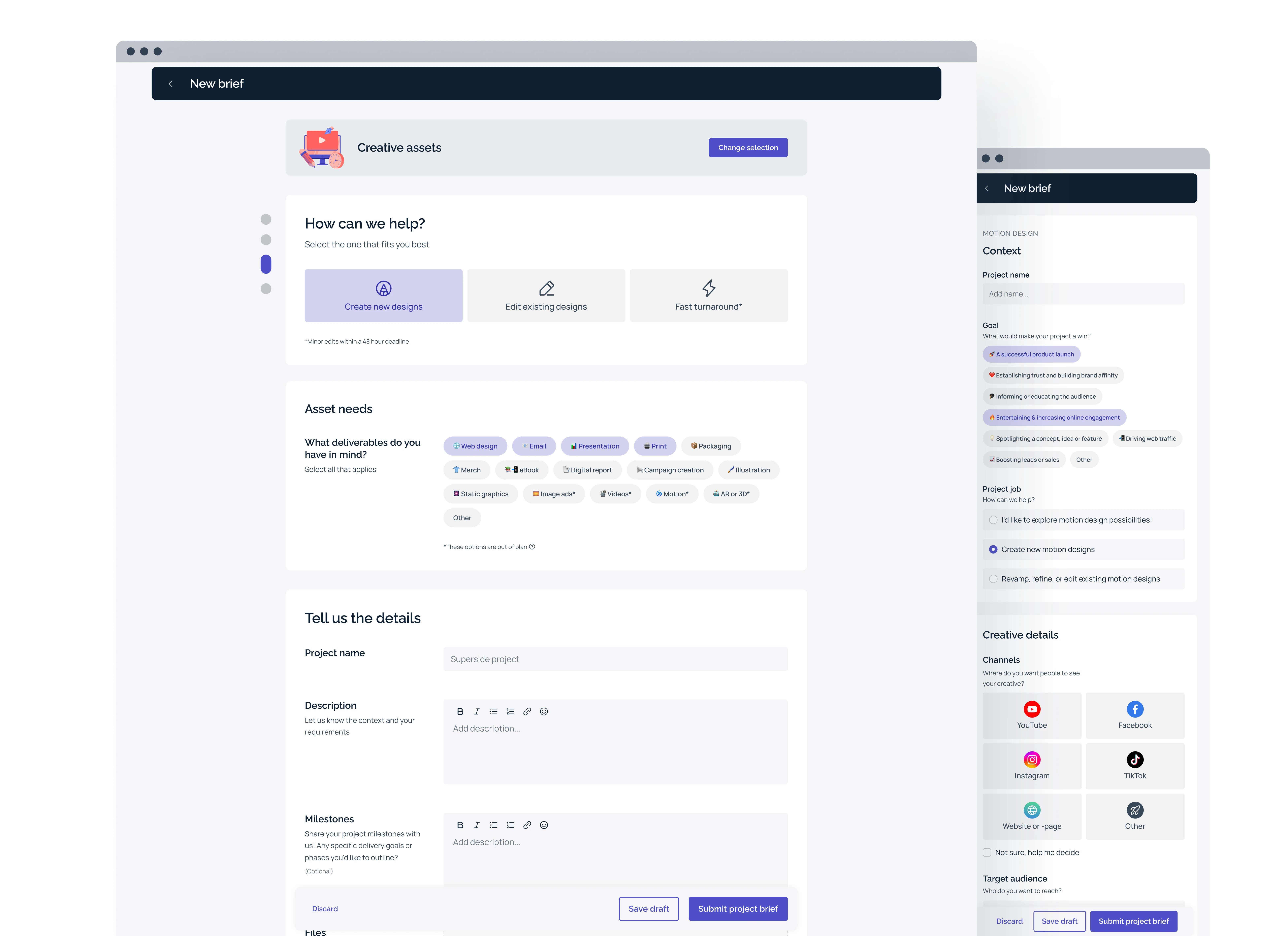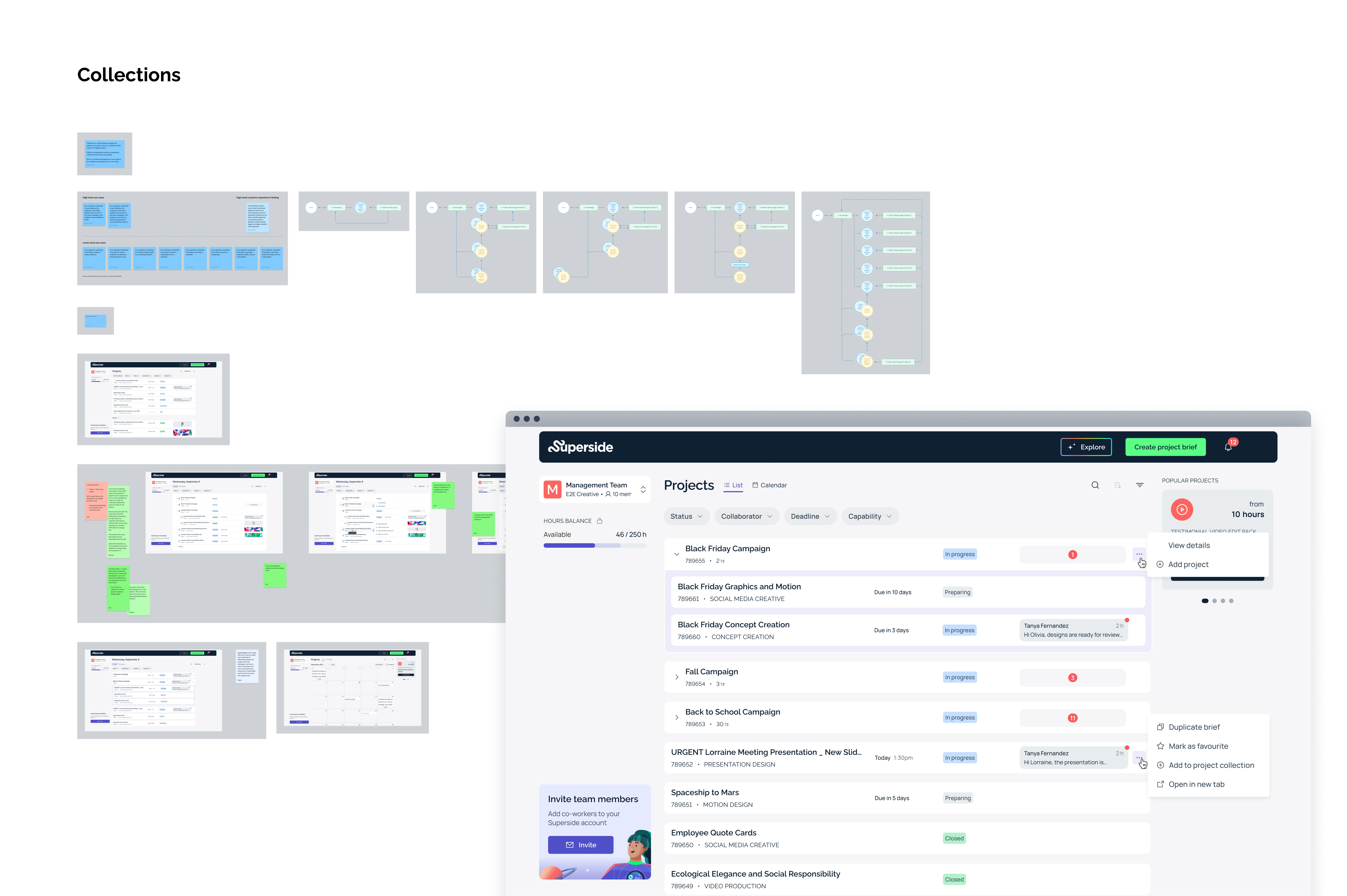Digital Marketing Brief

A briefing experience to shape customer perception of Superside as their creative service provider.
Role:
Senior Product Designer
Timeline:
Q1 2023 - Q3 2023
Employer:
Superside
Employer size:
700-800 staff members
Team and Role
Within the company, briefing forms served as the main tool for customers to convey their creative needs, be it refining a PowerPoint presentation or coming up with a concept for a comprehensive advertising campaign across various platforms.
A new team was established at the beginning of 2023, to tackle the platform briefing experience as a whole. The briefing experience at the time had been built while the company was in its very early stages, and had since been largely untouched.
I was the Senior Product Designer on the new Briefing Team, together with a Product Manager, an engineering manager, front-end engineers, and back-end engineers. As a team, we collaborated closely, and my role as the designer encompassed the entire end-to-end design process.
Problem and Business Impact
Our briefing experience needed to tackle some apparent issues: It had to provide our creative teams with the necessary information to kickstart projects effectively, while also remaining straightforward and directly relevant to our customers, ensuring seamless brief submission. The more briefs submitted, the more work for our creative teams.
As a team, we worked on big and small problems in parallel. I started by improving the UX/UI of the existing experience while doing a more in-depth design discovery, to uncover less obvious problems and opportunities related to our briefing process.
At the time, we knew disruption was coming. The company had started as a remote "PowerPoint factory," and over time grown to become a full-fledged digital creative agency. However, a substantial portion of customer deliverables were still limited to the production of creative assets, and the unmistakable presence of AI loomed, ready to assume a more significant role.
Strategically we needed to make a company-wide shift towards becoming a more strategic creative partner for our customers to stay relevant, which tied into the briefing product discovery.
User Research and Discovery
The discovery consisted of activities such as conducting interviews, creating user journeys and flows, organizing workshops with stakeholders, and synthesizing and communicating findings.
Key findings
Unintended Positioning
Our briefing experience presented Superside as a creative asset production company.
Confusing presentment of options
The many briefing choices were confusing, and sometimes overlapping, as they presented an overwhelming array of creative production options for our customers.
Scope inboxing
We inadvertently constrained the scope of each brief by starting the briefing process with the choice of a single creative capability for each customer brief.
"Once I began working with Superside, I soon learned that it's more like a production and execution service compared to the other creative agencies I've worked with."
- customer interview
Reframing the Problem
Our findings implied that we had been positioning ourselves as a creative asset production partner and subtly encouraging smaller briefs from our clients. This was detrimental, given our subscription-based business model, which allocated a set amount of creative hours each month to our customers.
We needed to change the briefing experience to teach our customers that we were a service provider who could support them in more substantial portions of the creative process, rather than exclusively in the final stages.
Outcome
By the end of three quarters, I had redesigned the briefing entry point three times, step by step. Supporting new learnings and new services along the way. The cadence in our product team allowed us to build and ship smaller parts of a design vision I had prototyped, analyze the performance through feedback, tracking, and tools such as Datadog, and adjust the designs accordingly.
The key findings from my initial discovery process guided our team's work as we went along.
I also devised briefing form design guidelines, as well as conducted a design process with all of our internal Capability Leads to ensure relevant questions in each briefing form. I used the results from this process to redesign and restructure all of our briefing forms, which were sixteen different forms at the time, with branching, and took the form UX from a wizard experience to a one-page experience.
The team successfully accomplished the following, as documented by our Project Manager:
Time to brief
±10% more projects are briefed in under 10 minutes since the new designs have been implemented.
Time from brief submission to project start
This number has consistently dropped over the last 6 months. The latest numbers are showing a 20-40% improvement.
Effectiveness
±1500 projects submitted per month through the briefing experience with a CSAT of more than 90%.
What's Next?
In the final quarter of my time at Superside, I embarked on a design exploration that we called "Multi-Capability Briefing." This term represented our aim to encourage customers to submit briefs with a more expansive creative scope. I redesigned the briefing entry point yet again, encouraging higher-scope briefs, and strategic projects that would cascade and eventually multiply the creative work for Superside. I brought down the number of forms from sixteen to four. We launched these changed to a select group of customer accounts, and the initial results were positive.
I translated this concept into "Collections," a feature to group projects, taking into account the technological complexities around projects inside our platform and the operational adjustments required to accommodate increasingly substantial projects.
I then passed on this concept and further form optimization to my successor, with whom I had the privilege of spending two weeks onboarding and mentoring, and I'm happy this concept will have a positive impact on Superside's future.
"Really impressed with the progress in “Multi-Capability Brief,” you’ve been able to conceptualize and concretize something that is indeed very vague and complex in a way that is both simple and flexible, well done!!!
Also excited to see that we are progressing “Collections!” This concept tackles a challenge that has been a topic since forever, and I think this very light and flexible approach is a great way to start and learn!"
- Superside COO
Reflections
My work on Superside's briefing process allowed me to engage deeply with the company's core IT infrastructure—a platform crucial to its business operations. This system serves as the backbone for all creative teams, enabling them to establish, organize, and oversee projects for our subscribing customers.
As a designer, this experience provided a unique opportunity to explore the behaviors of two key groups in relation to the platform:
Our Customers:
How and why do they submit briefs in their particular manner?
What influences their approach to project requests?
Our Creative Teams:
How do they interpret and act on these briefs?
What types of projects have they typically executed?
Can we influence their workflow through platform modifications?
As we began implementing changes to the briefing experience, it became clear that these adjustments could significantly impact both our customers and internal operations. Superside's agile nature and current organizational stage allowed for rapid iteration and implementation of changes.
Personally, I found it exciting to be part of this process. Seeing the tangible effects of my designs in action, especially as they contributed to Superside's evolution.
